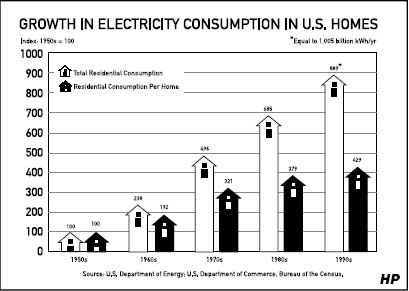May 2001
People renovate their homes for lots of good reasons - usually as their needs, and incomes, grow. But homeowners often overlook the fact that household electrical consumption has grown enormously over the years, yet the wiring in most homes remains basically unchanged from the time they were built.
So here's a thought that's not as crazy as it sounds: Should you consider renovating your home with new electrical wiring? And while you're at it, why not install all-new wiring for your phone, television and home entertainment equipment, home computer and other low-voltage telecommunications needs?
The facts are compelling for just such a retrofit. In the 1950s, at the start of the continuing building boom, all of the homes in the USA used a total of 113 billion kilowatt-hours (kWh) of electricity in an average year. By the 1990s, consumption had risen to nearly 9 times that amount, averaging over 1,000 billion kWh a year.
The number of homes also increased during that time, but individual home electrical use still rose by more than 400 percent - a spectacular increase, by any standard .

Does anyone believe this trend is likely to reverse, or even slow down? If you live in an older home, or in any home built to minimum electrical code standards, the chances are good that your electrical system is already working near or beyond its intended capacity. Although all properly installed wiring systems have built-in safety features, any system can be overloaded - or, worse, can become a hazard to those using it.
Your family's safety is most important, but there's also the inconvenience of living with a system that can't keep up with your needs. Sudden power outages, circuit breakers that trip often or fuses that blow repeatedly, a shortage of outlets throughout the house, home computers that crash during routine operations - these are just some of the symptoms of inadequate or obsolete electrical wiring. Any homeowner who has ever had to move furniture to find an available place to plug in knows that you can't have too many outlets.
To meet our ever-increasing demand, 1 2 - AWG solid-copper wiring, rather than thinner 14-AWG wiring, is the minimum recommended for home wiring circuits. Installing any number of additional outlets and new circuits, along with upgrading a home's electrical service panel beyond the 100-amp minimum, is a routine retrofit job for an electrician.
Take a look at our quick 10 item questionnaire that can help you evaluate your home's electrical needs and capacity and provide installation questions to ask an electrician. ![]()
